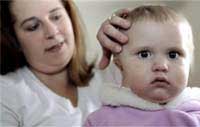What seemed like a simple seizure turned into a shocking reality when little Alexzandra Gonzales suddenly jerked and then slumped down, breathing weakly. After a frantic rush to the hospital, Gonzales’ parents could hardly believe their ears when they learned that their daughter had suffered a stroke just days before her first birthday.
 |
|
Little Alexzandra Gonzales and her mother after receiving treatment for the stroke |
“We never thought children could have strokes,” said Gonzales’ mother, Amanda Gonzales, choking back tears. This is a common misconception, as in reality, thousands of children in the United States suffer strokes each year. Experts are increasingly concerned that this situation is on the rise. Approximately 10-25% of children who have strokes die.
While strokes are rare in children, Dr. John Lynch from the National Institutes of Health (NIH) estimates that about 1,000 infants experience this condition annually, along with around 3,000-5,000 children under 18 months old. The age difference is crucial because strokes in infants differ from those in older children, as infants face a significantly higher risk of brain damage.
Some experts believe that most children who survive strokes can recover quickly, as their brains are more “plastic” than those of adults. However, recent studies indicate that more than half of those who recover will suffer from permanent disabilities related to movement and cognition.
To date, there has been very little research on how to treat strokes in young children. Treatments designed for adults are still applied, even though it is known that the causes of stroke in adults, such as blood clots or atherosclerosis, are not the culprits in children.
Currently, more than two-thirds of strokes in children have unknown causes, although congenital heart defects, vascular incidents, and certain infectious diseases are believed to trigger strokes in young ones. NIH research suggests that genetic mutations related to clot formation and metabolic mechanisms may also be responsible.
In the case of little Alexzandra Gonzales, just three days after being hospitalized, she experienced another stroke on her birthday. Surgeons had to remove part of her skull to allow for the swelling brain. A week after waking up, this one-year-old seemed as though she had just been born, unable to move or even lift her head. Doctors are still uncertain about the cause of Alexzandra’s stroke, but she was fortunate to receive timely medical attention. In many instances, parents fail to recognize the dangerous signs of acute stroke symptoms such as weakness on one side of the body, difficulty speaking, and notably, seizures.
According to Dr. Raymond Pitetti from the Children’s Hospital of Pittsburgh, only by recognizing the early signs of stroke in young children and providing timely treatment can there be hope for saving the brain.
My Linh



















































